人教版高中英语必修1教案Unit4Earthquakes
- 格式:docx
- 大小:27.14 KB
- 文档页数:21
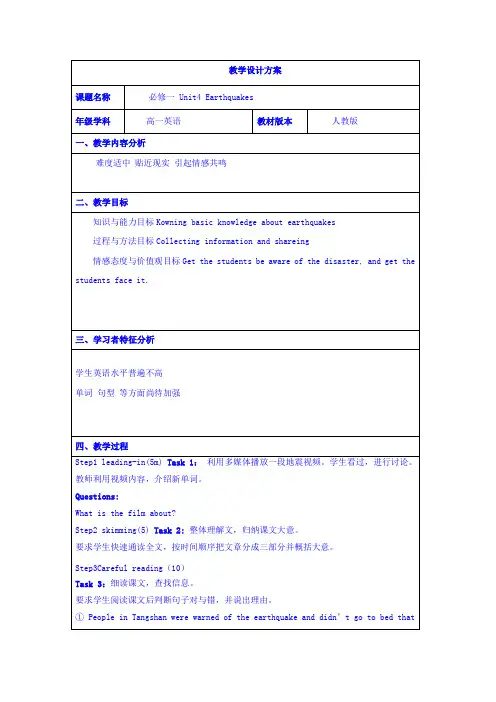
品味人生1、不管鸟的翅膀多么完美,如果不凭借空气,鸟就永远飞不到高空。
想象力是翅膀,客观实际是空气,只有两方面紧密结合,才能取得显着成绩。
2、想停下来深情地沉湎一番,怎奈行驶的船却没有铁锚;想回过头去重温旧梦,怎奈身后早已没有了归途。
因为时间的钟摆一刻也不曾停顿过,所以生命便赋予我们将在汹涌的大潮之中不停地颠簸。
3、真正痛苦的人,却在笑脸的背后,流着别人无法知道的眼泪,生活中我们笑得比谁都开心,可是当所有的人潮散去的时候,我们比谁都落寂。
4、温暖是飘飘洒洒的春雨;温暖是写在脸上的笑影;温暖是义无反顾的响应;温暖是一丝不苟的配合。
5、幸福,是一种人生的感悟,一种个人的体验。
也许,幸福是你风尘仆仆走进家门时亲切的笑脸;也许,幸福是你卧病床上百无聊赖时温馨的问候;也许,幸福是你屡遭挫折心灰意冷时劝慰的话语;也许,幸福是你历经艰辛获得成功时赞赏的掌声。
关键的是,你要有一副热爱生活的心肠,要有一个积极奋进的目标,要有一种矢志不渝的追求。
这样,你才能感受到幸福。
6、母爱是迷惘时苦口婆心的规劝;母爱是远行时一声殷切的叮咛;母爱是孤苦无助时慈祥的微笑。
7、淡淡素笺,浓浓墨韵,典雅的文字,浸染尘世情怀;悠悠岁月,袅袅茶香,别致的杯盏,盛满诗样芳华;云淡风轻,捧茗品文,灵动的音符,吟唱温馨暖语;春花秋月,红尘阡陌,放飞的思绪,漫过四季如歌。
读一段美文,品一盏香茗,听一曲琴音,拾一抹心情。
8、尘缘飞花,人去楼空,梦里花落为谁痛?顾眸流盼,几许痴缠。
把自己揉入了轮回里,忆起,在曾相逢的梦里;别离,在泪眼迷朦的花落间;心碎,在指尖的苍白中;淡落,在亘古的残梦中。
在夜莺凄凉的叹息里,让片片细腻的柔情,哽咽失语在暗夜的诗句里。
9、用不朽的“人”字支撑起来的美好风景,既有“虽体解吾犹未变兮”的执着吟哦,也有“我辈岂是蓬蒿人”的跌宕胸怀;既有“我以我血荐轩辕”的崇高追求,也有“敢教日月换新天”的豪放气魄。
33 我是一只蜜蜂,在祖国的花园里,飞来飞去,不知疲倦地为祖国酿制甘甜的蜂蜜;我是一只紫燕,在祖国的蓝天上,穿越千家万户,向祖国向人民报告春的信息;我是一滴雨点,在祖国的原野上,从天而降,滋润干渴的禾苗;我是一株青松,在祖国的边疆,傲然屹立,显示出庄严的身姿。
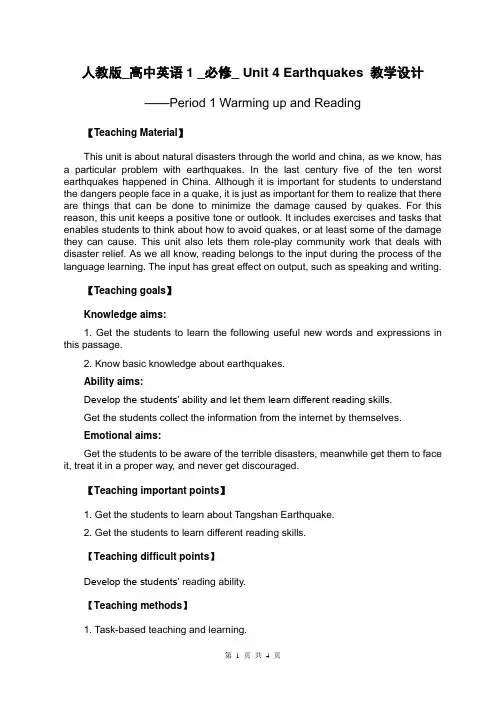
人教版_高中英语1 _必修_ Unit 4 Earthquakes 教学设计——Period 1 Warming up and Reading【Teaching Material】This unit is about natural disasters through the world and china, as we know, has a particular problem with earthquakes. In the last century five of the ten worst earthquakes happened in China. Although it is important for students to understand the dangers people face in a quake, it is just as important for them to realize that there are things that can be done to minimize the damage caused by quakes. For this reason, this unit keeps a positive tone or outlook. It includes exercises and tasks that enables students to think about how to avoid quakes, or at least some of the damage they can cause. This unit also lets them role-play community work that deals with disaster relief. As we all know, reading belongs to the input during the process of the language learning. The input has great effect on output, such as speaking and writing.【Teaching goals】Knowledge aims:1. Get the students to learn the following useful new words and expressions in this passage.2. Know basic knowledge about earthquakes.Ability aims:Develop the students’ ability and let them learn different reading skills.Get the students collect the information from the internet by themselves.Emotional aims:Get the students to be aware of the terrible disasters, meanwhile get them to face it, treat it in a proper way, and never get discouraged.【Teaching important points】1. Get the students to learn about Tangshan Earthquake.2. Get the students to learn different reading skills.【Teaching difficult points】Develop the students’ reading ability.【Teaching methods】1. Task-based teaching and learning.2. Fast reading, intensive reading3. Discussion.【Teaching aids:】CAI课件, A tape recorder【Teaching procedures】Step 1 Warming upWarming up by lookingShow Ss some pictures about natural disasters and ask them two questions.1. Can you tell some natural disasters?(volcano, fire, sandstorm, typhoon, hailstone, thunderstorm, flood, hurricane, earthquake)2. Have you ever experienced an earthquake? Can you describe how terrible an earthquake is?(The earth is shaking; all the buildings will fall down; many people will die; many children will become orphans.)Warming up by discussingNow, look at the pictures of Tangshan and San Francisco in warming up and describe what you see in the pictures.(Beautiful cities; broad roads; tall building; large population...)What will happen if there has been a big earthquake in these two cities?As we all know, earthquakes are disasters to everyone. But can we avoid or at least reduce the loss caused by earthquakes? Can we foretell earthquakes? Now let’s come to Pre-reading and decide what may happen before an earthquake comes.Step 2 Pre-readingImaging and sharingImagine there is an earthquake now. Your home begins to shake and you must leave it right away. You have time to take only one thing. What will you take? Is it money, water, fruits, mobile, phones, a torch light, or anything else? Why?Talking and sharingWhat are the signs of an earthquake? Talk about the pictures on Page 25.(e.g. Cows, pigs and dogs become too nervous too eat. The mice will run out of the fields looking for places to hide. The water in the wells will rise and fall. Walls of the wells in village will have deep cracks. There will be bright light in the sky….) Step 3 ReadingTell the students: Today, we are going to read a news report about the strongest earth-quake in China’s history, which happened in Tangshan, Hebei, in 1976.1. Fast readingAsk the students to read the passage quickly.1) Answer some questions.Ask the students to read the passage quickly and pay attention to the first sentence of each paragraph.2) Find out the topic sentences of each paragraph and get the general idea of the passage.3) Do some true or false exercises.Ask the students to decide whether the following statements are true or false. If it is false, try to correct it.2. Reading carefullyAsk the students to read the passage carefully to lacate particular information.1) Do the exercises in the part Comprehending on Page 27.2) Do some multiple choices.3. Language problemsWhile checking the answers with the whole class,deal with any language problems that the students can’t understand.4. Reading aloudPlay the tape of the passage for the students to listen and follow. Then play the tape of Paragraph 1 of the passage once more; this time the students listen and repeat.Step 4 GameWork in pairs. Supose you are a newspaper reporter, and other is a witness of the 1976 Tangshan Earthquake. Now the newspaper reporter is interviewing the witness.Step 5 DiscussionHow can we protect ourselves in the earthquake?Earthquake Survival TipsDriving --- pull over and stay in your car.In a building--- get near a strong wall / The corner of the room is the safest.Having classes--- listen to the teacher’s instruction, protect their heads and hide under the desks.On buses--- Grasp the handles to avoid being injured; lower the center of gravity; hide near the seats; get off after the earthquake passed.Step 6 HomeworkP review the reading “A Night the Earth didn’t Sleep” and learn new words of this unit.。
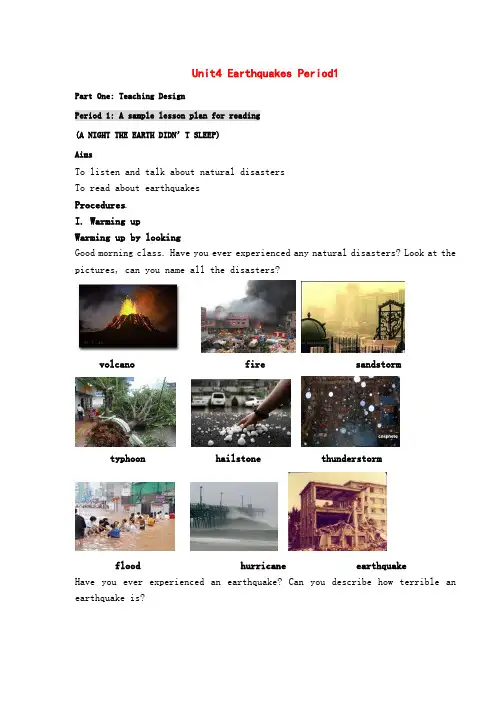
Unit4 Earthquakes Period1Part One: Teaching DesignPeriod 1: A sample lesson plan for reading(A NIGHT THE EARTH DIDN’T SLEEP)AimsTo listen and talk about natural disastersTo read about earthquakesProceduresI. Warming upWarming up by lookingGood morning class. Have you ever experienced any natural disasters? Look at the pictures, can you name all the disasters?volcano fire sandstormtyphoon hailstone thunderstormflood hurricane earthquakeHave you ever experienced an earthquake? Can you describe how terrible an earthquake is?(The earth is shaking; all the buildings will fall down; many people will die; many children will bec ome orphans.)Warming up by discussingNow, look at the pictures of Tangshan and San Francisco in warming up and describe what you see in the pictures. (beautiful cities; broad roads; tall building; large population.)What will happen if there has been a big earthquake in these two cities?As we all know, ea rthquakes are disasters to everyone. But can we avoid or at least reduce the loss caused by earthquakes? Can we foretell earthquakes? Now let’s come to Pre-reading and decide what may happen before an earthquake comes. II. Pre-reading1.Talking and sharingWhat are the signs of an earthquake? (e.g. Cows, pigs and dogs become too nervous too eat. The mice will run out of the fields looking for places to hide. The water in the wells will rise and fall. Walls of the wells in village will have deep cracks. There will be bright light in the sky….)2. Imaging and sharingImagine there is an earthquake now, your home begins to shake and you must leave it right away. You have time to take only one thing. What will you take? Why? III. Reading1. Listening and fast readingNow let’s come to the tex t “A NIGHT THE EARTH DIDN’T SLEEP” and see what it tells us.Please listen to the text and get the general ide a of the passage. You should pay attention to the first sentences of each paragraph. In what order is the text written? (The text is written in time order. The general idea is the mixture of the first sentences of each paragraph, that is, the text tells us something that happened before the earthquake, during the earthquake and after the earthquake.)2. Reading an d underliningNext you are to read and underline all the useful expressions or collocations in the passage. Copy them in your notebook after class as homework. Collocations fro m A NIGHT THE EARTH DIDN’T SLEEPa smelly gas, come out of, in the farmyards, too nervous to eat, run out of,for place to hide, water pipes, think little of sth., as usual, it seemed tat anend, one hundred kilometers away, one-third, eight kilometers long, th meterswide, cut across, in ruins, be injury, the number of, reach more than 400, everywhere, everything was destroyed, be gone, blow away, sth. be not safetens of thousands of, give milk, half a million, instead of, be shocked, lthat afternoon,be trapped under the ruins, fall down, all…is/was not…,hun dreds of thousof,dig out, the dead, to the north of, coal mines, built shelters, fresh wat3. Reading aloud and translatingNext we are going to read aloud the text and translate it into Chinese.4. Reading and transforming informationRead the text again and answer the following questions.1. What natural signs of coming disaster were there?2. Can you think of some reason s why these signs weren’t noticed?3. Can you describe the disaster caused by the earthquake?4. What events and situations probably made the disaster worse?5. How were the survivors helped?6. Could anything more have been done to help the survivors? Why or why not? Answers: 1, 3, 4, 5 are easy to answer.2. Maybe at that time people didn’t have knowledge of an earthqu6. The students have their own answers.4. Discussing writing styleAs you have understood the general idea of the text, I still put more questionsto you.1.From whose point of view are events described? How do you know? (Awriterwho didn’t see the quake uses the third person “they” when he writes.)2.Why do you think the writer chose to express her feelings about the quakerather than simply report what happened? (Although the writer was notthere he felt sad for the people of Tang Shan. He knows that giving somefeelings will make the read ing more interesting.)3.Why is the title “A NIGHT THE EARTH D I DN’T SLEEP”? (As usual, nightis the time to sleep, and night should be quiet and safe. But that nighteverything changed. The writer used it as a title to show how terribleand how unusual that night is.)5. Reading and understanding difficult sentences.If you have some difficult sentences to understand, come to me for help.IV. Closing down Closing down by doing exercisesNow please do the comprehending Exercises 1, 2 and 3 on page 27.Closing down by discussingBy now you’ve known that earthquakes are terrible natural disasters andthat China is unlucky enough to have a lot of them. Now imagine that yourgroup lives in the city that has a lot of earthquakes, what should youdo during an earthquake? Look at the given situation and discuss in pairs.(1) If you are OUTDOORS, …(2) If you are in a HIGH BUILDING, …(3) If you are DRIVING, …(4) If you are HAVING CLASS, …(5) If you are in a CINEMA, …What should you do during the earthquake?Situation:(1) how to rescue those still trapped in the ruins;(2) how to take care of the survivors;(3) how to repair buildings that survived the earthquake;(4) what to do with the buildings that survived the earthquake;(5) where to find people to help build a new city;(6) how to teach children about earthquake safety;(7) where to put information for survivors and their families;(8) how to plan for further disasters.。
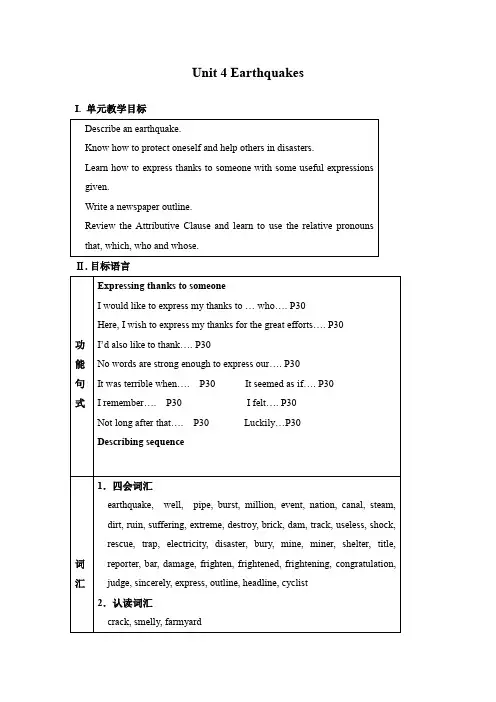
Unit 4 Earthquakes I.单元教学目标Ⅱ.目标语言Ⅲ. 教材分析与教材重组1.教材分析本单元以地震为中心话题,介绍了地震这一自然现象,使大家对地震的起因、前兆、危害及如何在震中自救等有了较全面的了解。
各项语言活动主要围绕这个中心内容对人,事,物进行了描述。
这些练习内容让学生思考如何去避免地震或至少是避免太多的损失。
即对于灾难要有正确的认识,要用积极的态度来对待它。
1.1 Warming-up用唐山和旧金山的两幅图片导入本单元,旨在让学生运用有关知识去描述所见图片,并发挥想象力来描述震后这两个城市的情景。
带着疑问去学新知识,来完善自己对地震的认识。
另一方面,它也为学生提供了功能项目、短语词汇、和语法知识方面的练习。
1.2 Pre-reading是Warming-up的延续。
它由对图片的想象转入到经历地震的想象中。
由两个问题组成。
第一个问题其目的是提高学生在危急关头的应变能力,第二个问题旨在培养学生对周围事物的观察能力,并结合图片培养学生运用语言的能力,也对课文内容作了伏笔。
1.3 Reading从内容来看,它包含了地震的方方面面;从功能项目来看,它包含了本单元大部分的词汇和语法内容,为下一步的语言运用做好了准备。
这是一篇新闻报道,记述了唐山地震的前兆,经过,危害及救援工作。
整篇文章语言生动,扣人心弦,能让人感到地震的可怕性,也能感到政府对灾区人民的关怀。
体现出了人类在自然灾害面前的脆弱和战胜困难时体现出来的集体主义精神。
同时也让学生对灾难临头时如何自救等知识有所了解。
1.4 Comprehending是对目标语言的全面练习,也指导了学生的学习方法和步骤。
它要求学生从字、词、句、语段总体上去把握课文内容。
1.5 Learning about language是继Comprehending之后又一指导性练习。
它着重从词的意义、用法和表达法方面对学生学习英语词汇给予了指导。
尤其是对as if句型和定语从句进行了专练。
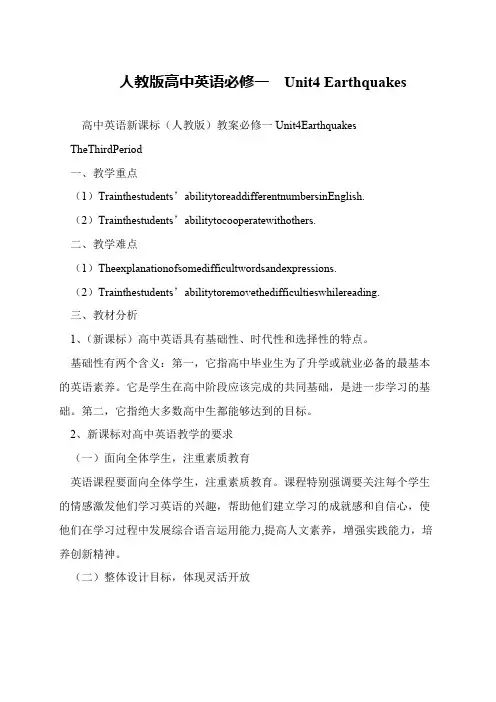
人教版高中英语必修一Unit4 Earthquakes
高中英语新课标(人教版)教案必修一Unit4Earthquakes
TheThirdPeriod
一、教学重点
(1)Trainthestudents’abilitytoreaddifferentnumbersinEnglish.
(2)Trainthestudents’abilitytocooperatewithothers.
二、教学难点
(1)Theexplanationofsomedifficultwordsandexpressions.
(2)Trainthestudents’abilitytoremovethedifficultieswhilereading.
三、教材分析
1、(新课标)高中英语具有基础性、时代性和选择性的特点。
基础性有两个含义:第一,它指高中毕业生为了升学或就业必备的最基本的英语素养。
它是学生在高中阶段应该完成的共同基础,是进一步学习的基础。
第二,它指绝大多数高中生都能够达到的目标。
2、新课标对高中英语教学的要求
(一)面向全体学生,注重素质教育
英语课程要面向全体学生,注重素质教育。
课程特别强调要关注每个学生的情感激发他们学习英语的兴趣,帮助他们建立学习的成就感和自信心,使他们在学习过程中发展综合语言运用能力,提高人文素养,增强实践能力,培养创新精神。
(二)整体设计目标,体现灵活开放。
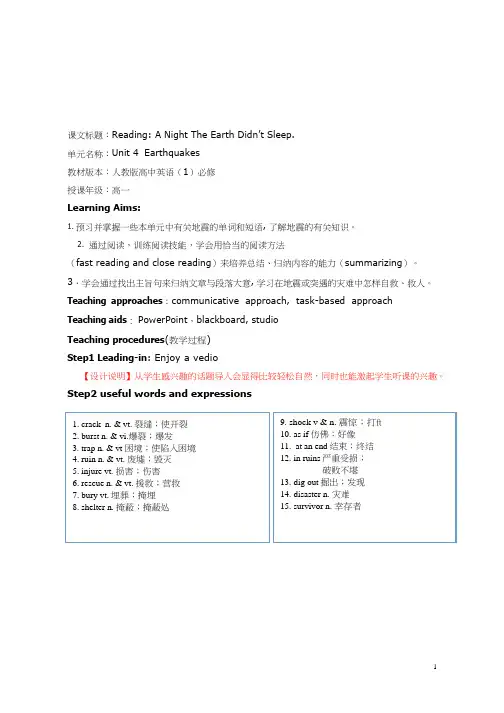
课文标题:Reading: A Night The Earth Didn’t Sleep.单元名称:Unit 4 Earthquakes教材版本:人教版高中英语(1)必修授课年级:高一Learning Aims:1.预习并掌握一些本单元中有关地震的单词和短语, 了解地震的有关知识。
2.通过阅读,训练阅读技能,学会用恰当的阅读方法(fast reading and close reading)来培养总结、归纳内容的能力(summarizing)。
3.学会通过找出主旨句来归纳文章与段落大意, 学习在地震或突遇的灾难中怎样自救、救人。
Teaching approaches:communicative approach, task-based approach Teaching aids:PowerPoint,blackboard, studioTeaching procedures(教学过程)Step1 Leading-in: Enjoy a vedio【设计说明】从学生感兴趣的话题导入会显得比较轻松自然,同时也能激起学生听课的兴趣。
Step2 useful words and expressions【设计说明】单词是基础,复习巩固生词为下一步阅读扫清障碍。
Step3 Fast-readingTry to get the structures of the passage main idea of the text .【设计说明】旨在锻炼学生快速搜索信息的能力。
跳读找出文章的主体大意及各段的主题,这样设计是为让学生了解、抓住本文的主题思想,为下一步细读做准备。
Step4 Careful readingPart 1 Before the earthquake: the signs【设计说明】文章较长,采取分段学习,课文层次清晰,学生自读与听力相结合,能帮助学生理解与提高听力水平,通过与搭档相互核对答案同时培养了学生合作学习的意识。
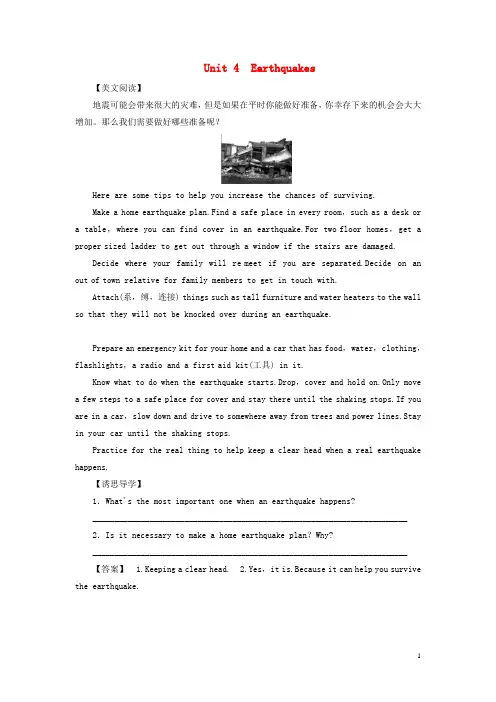
Unit 4 Earthquakes【美文阅读】地震可能会带来很大的灾难,但是如果在平时你能做好准备,你幸存下来的机会会大大增加。
那么我们需要做好哪些准备呢?Here are some tips to help you increase the chances of surviving.Make a home earthquake plan.Find a safe place in every room,such as a desk or a table,where you can find cover in an earthquake.For two-floor homes,get a proper-sized ladder to get out through a window if the stairs are damaged.Decide where your family will re-meet if you are separated.Decide on an out-of-town relative for family members to get in touch with.Attach(系,缚,连接) things such as tall furniture and water heaters to the wall so that they will not be knocked over during an earthquake.Prepare an emergency kit for your home and a car that has food,water,clothing,flashlights,a radio and a first-aid kit(工具) in it.Know what to do when the earthquake starts.Drop,cover and hold on.Only move a few steps to a safe place for cover and stay there until the shaking stops.If you are in a car,slow down and drive to somewhere away from trees and power lines.Stay in your car until the shaking stops.Practice for the real thing to help keep a clear head when a real earthquake happens.【诱思导学】1.What's the most important one when an earthquake happens?________________________________________________________________________ 2.Is it necessary to make a home earthquake plan?Why?________________________________________________________________________ 【答案】 1.Keeping a clear head. 2.Yes,it is.Because it can help you survive the earthquake.Period ⅠPreviewing(教师用书独具)●教学目标本课时主要是通过学生对学案所给出的内容的学习,了解本课文中所出现的词汇,初步了解课文以及相关的背景知识,对下一堂课全面理解课文起到一个铺垫作用。
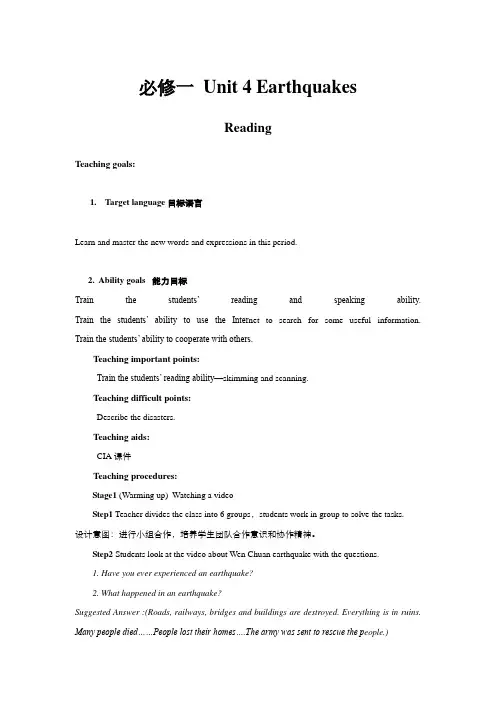
必修一 Unit 4 EarthquakesReadingTeaching goals:1.Target language 目标语言Learn and master the new words and expressions in this period.2. Ability goals 能力目标Train the students’ reading and speaking ability. Train the students’ ability to use the Inter net to search for some useful information. Train the students’ ability to cooperate with others.Teaching important points:Train the students’ reading ability—skimming and scanning.Teaching difficult points:Describe the disasters.Teaching aids:CIA课件Teaching procedures:Stage1 (Warming up) Watching a videoStep1 Teacher divides the class into 6 groups,students work in group to solve the tasks.设计意图:进行小组合作,培养学生团队合作意识和协作精神。
Step2 Students look at the video about Wen Chuan earthquake with the questions.1. Have you ever experienced an earthquake?2. What happened in an earthquake?Suggested Answer :(Roads, railways, bridges and buildings are destroyed. Everything is in ruins. Many people died……People lost their homes….The army was sent to rescue the p eople.)3. How many several terrible earthquakes do you know in the world?Suggested Answer:(Japanese earthquake March 11st, 2011 Gansu yushu earthquake April 14th, 2010 Haiti earthquake January 12nd, 2010 Sichuan wenchuan earthquake May 12nd, 2008 Hebei Tangshan earthquake July 28th, 1976)设计意图:利用视频导入,一方面能激发学生的学习兴趣和背景知识,另一方面为下文的主题做好铺垫。
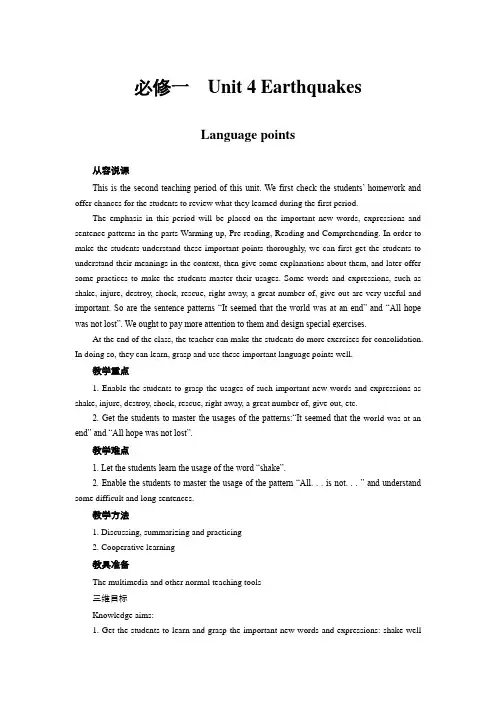
必修一Unit 4 EarthquakesLanguage points从容说课This is the second teaching period of this unit. We first check the students‟ homework and offer chances for the students to review what they learned during the first period.The emphasis in this period will be placed on the important new words, expressions and sentence patterns in the parts Warming up, Pre-reading, Reading and Comprehending. In order to make the students understand these important points thoroughly, we can first get the students to understand their meanings in the context, then give some explanations about them, and later offer some practices to make the students master their usages. Some words and expressions, such as shake, injure, destroy, shock, rescue, right away, a great number of, give out are very useful and important. So are the sentence patterns “It seemed that the world was at an end” and “All hope was not lost”. We ought to pay more attention to them and design special exercises.At the end of the class, the teacher can make the students do more exercises for consolidation. In doing so, they can learn, grasp and use these important language points well.教学重点1. Enable the students to grasp the usages of such important new words and expressions as shake, injure, destroy, shock, rescue, right away, a great number of, give out, etc.2. Get the students to master the usages of the patterns:“It seemed that the world was at an end” and “All hope was not lost”.教学难点1. Let the students learn the usage of the word “shake”.2. Enable the students to master the usage of the pattern “All. . . is not. . . ” and understand some difficult and long sentences.教学方法1. Discussing, summarizing and practicing2. Cooperative learning教具准备The multimedia and other normal teaching tools三维目标Knowledge aims:1. Get the students to learn and grasp the important new words and expressions: shake well(n. )rise crack smelly burst canal ruin injure destroy useless shock quake rescue electricity disaster army organize bury coal mine shelter fresh right away at an end lie in ruins be trapped under sth. a (great)number of2. Get the students to learn the following useful sentence patterns:1) But the one million people of the city, who thought little of these events, went to bed as usual that night.2) It seemed that the world was at an end!3) Bricks covered the ground like red autumn leaves.4) The army organized teams to dig out those who were trapped and to bury the dead.5) Workers built shelters for survivors whose homes had been destroyed.6) Never before in history has a city been so completely destroyed.Ability aims:1. Enable the students to use some useful words and expressions correctly.2. Enable the students to make sentences after the useful sentence patterns.Emotional aim:1. Stimulate the students‟ interest in learning English.2. Develop the students‟ spirit of cooperation and teamwork.教学过程设计方案(一)→Step 1 Revision1. Check the homework exercises.2. Ask some students to retell the reading passage A Night the Earth Didn‟t Sleep.→Step 2 Reading and findingGet the students to read the reading passage again to underline all the new words and useful expressions or collocations in the passage.Collocations: a smelly gas, come out of, in the farmyards, too nervous to eat, run out of, look for places to hide, jump put of, water pipes, think little of, as usual, It seemed that. . . , at an end, one hundred kilometers away, one-third, eight kilometers long, thirty meters wide, cut across, in ruins, be injured, thousands of, the number of, reach more than 400 000, everywhere, . . . everything was destroyed, be gone, blow away, be not safe for, tens of thousands of, give milk, half a million, millions of, instead of, be shocked, later that afternoon, be trapped under the ruins, fall down, All. . . is/was not. . . , hundreds of thousands of, dig out, the dead, to the north of, coal mines, built shelters, fresh waterRead them aloud and copy them down in the exercise book after class.→Step 3 Discovering useful words and expressionsDo the exercises in Discovering useful words and expressions on Page 28.Explain the problems the students meet while checking the answers.→Step 4 Langu age Points1. shake vt. & vi(shook, shaken)1)(cause sb. / sth. to)move quickly and often jerkily from side to side or up and down(使某人或某物)急速摇动或颠簸The table shook when she banged her fist on it.她用拳头把桌子敲得直颤。
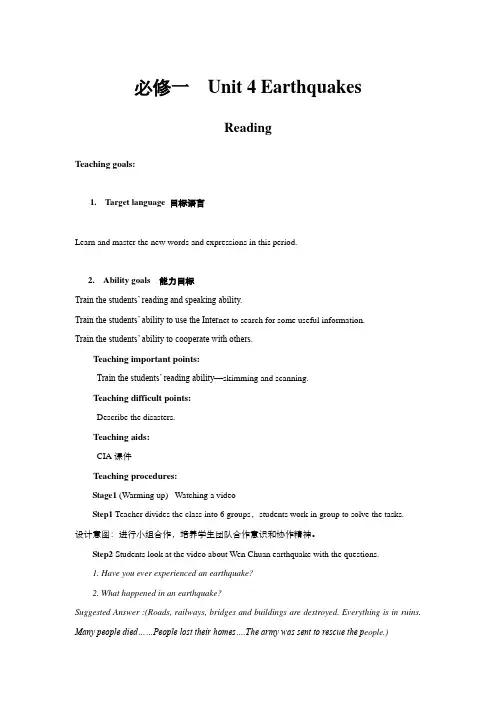
必修一Unit 4 EarthquakesReadingTeaching goals:1.Target language 目标语言Learn and master the new words and expressions in this period.2. Ability goals 能力目标Train the students’ reading and speaking ability.Train the students’ ability to use the Inter net to search for some useful information.Train the students’ ability to cooperate with others.Teaching important points:Train the students’ reading ability—skimming and scanning.Teaching difficult points:Describe the disasters.Teaching aids:CIA课件Teaching procedures:Stage1 (Warming up) Watching a videoStep1 Teacher divides the class into 6 groups,students work in group to solve the tasks.设计意图:进行小组合作,培养学生团队合作意识和协作精神。
Step2 Students look at the video about Wen Chuan earthquake with the questions.1. Have you ever experienced an earthquake?2. What happened in an earthquake?Suggested Answer :(Roads, railways, bridges and buildings are destroyed. Everything is in ruins. Many people died……People lost their homes….The army was sent to rescue the p eople.)3. How many several terrible earthquakes do you know in the world?Suggested Answer:(Japanese earthquake-- March 11st, 2011 Gansu yushu earthquake-- April 14th, 2010 Haiti earthquake-- January 12nd, 2010 Sichuan wenchuan earthquake-- May 12nd, 2008 Hebei Tangshan earthquake -- July 28th, 1976)设计意图:利用视频导入,一方面能激发学生的学习兴趣和背景知识,另一方面为下文的主题做好铺垫。
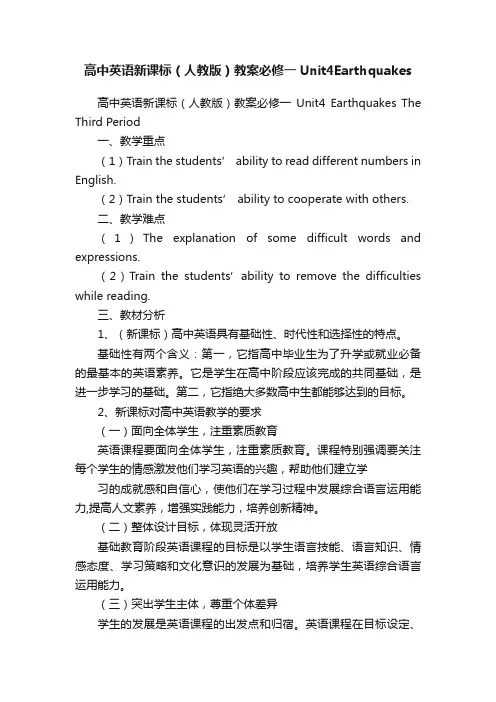
高中英语新课标(人教版)教案必修一Unit4Earthquakes高中英语新课标(人教版)教案必修一Unit4 Earthquakes The Third Period一、教学重点(1)Train the students’ ability to read different numbers in English.(2)Train the students’ ability to cooperate with others.二、教学难点(1)The explanation of some difficult words and expressions.(2)Train the students’ability to remove the difficulties while reading.三、教材分析1、(新课标)高中英语具有基础性、时代性和选择性的特点。
基础性有两个含义:第一,它指高中毕业生为了升学或就业必备的最基本的英语素养。
它是学生在高中阶段应该完成的共同基础,是进一步学习的基础。
第二,它指绝大多数高中生都能够达到的目标。
2、新课标对高中英语教学的要求(一)面向全体学生,注重素质教育英语课程要面向全体学生,注重素质教育。
课程特别强调要关注每个学生的情感激发他们学习英语的兴趣,帮助他们建立学习的成就感和自信心,使他们在学习过程中发展综合语言运用能力,提高人文素养,增强实践能力,培养创新精神。
(二)整体设计目标,体现灵活开放基础教育阶段英语课程的目标是以学生语言技能、语言知识、情感态度、学习策略和文化意识的发展为基础,培养学生英语综合语言运用能力。
(三)突出学生主体,尊重个体差异学生的发展是英语课程的出发点和归宿。
英语课程在目标设定、教学过程、课程评价和教学资源的开发等方面都突出以学生为主体的思想。
课程实施应成为学生在教师指导下构建知识、提高技能、磨砺意志、活跃思维、展现个性、发展心智和拓展视野的过程。
Unit 4 EarthquakesStep 1 课前准备——单元考点自查自测1.词汇分层级识记过关2.语境活用填写过关3.经典句式背诵仿写过关4.类词巧积累事半功倍(一)分门别类攻单词——识形辨意·拓展应用(二)写用结合记短语——译写短语·语境活用(三)仿写活用练句式——经典句型·仿写背诵Step 2 课堂探究——核心考点点点突破1.重点难点考点学通练透2.归纳总结拓展开阔视野3.方法规律技巧权威点拨4.面面俱到打创高效课堂第一时段Warming up & Reading1.burst vi.爆裂;爆发;突然迸发;冲;闯n.突然破裂;爆发[教材原句] In the city, the water pipes in some buildings cracked and burst.在市内,有些建筑物里的水管出现裂缝并爆裂开来。
(1)burst in/into 闯入;突然破门而入(2) ⎭⎪⎬⎪⎫burst out crying/laughing burst into tears/laughter 突然哭起来/笑起来 burst with anger 勃然大怒单句语法填空①On hearing the news, Mary burst ________ laughter while Lucy burst out ________(cry).②Last night the room ____________(burst) into but nothing was taken away.[答案] ①into; crying ②was burst2.ruin n .[U ]毁灭;毁坏;崩溃;[常用复数]废墟;遗迹 vt.(使)毁坏;成为废墟[教材原句] In fifteen terrible seconds a large city lay in ruins .在可怕的15 秒内,一座大城市成了废墟。
必修一 Unit 4 EarthquakesReading教学重点1. Get the students to know basic knowledge about natural disasters.2. Get the students to learn about Tangshan Earthquake.3. Get the students to learn different reading skills.教学难点Develop the students’ reading abi lity.教学方法1. Taskbased teaching and learning2. Cooperative learning3. Discussion教具准备The multimedia and other normal teaching tools三维目标Knowledge aims:1. Get the students to learn the following useful new words and expressions in this passage: shakewell (n. )risecracksmellypondpipeburstcanalsteamdirt ruininjuredestroybrickdamuselesssteelshockquakerescueelectricity disasterarmyorganizeburycoalmineshelterfreshright awayat an endlie in ruinsbe trapped under sth.a (great)number of2. Get the students to know basic knowledge about natural disasters.Ability aims:1. Develop the students reading ability and let them learn different reading skills.2. Train the students’ ability to collect useful information from the Internet by themselves.Emotional aim:1. Get the students know damages earthquakes bring about and the ways to reduce losses ofearthquakes.2. Get the students to know how to protect oneself and help others in earthquakes.3. Get the students to be aware of terrible disasters, meanwhile get them to face it, treat it in a proper way, and never get discouraged.教学过程设计方案(一)→Step 1 LeadinShow the students some pictures about natural disasters and ask them:1. Have you ever experienced any natural disaster? Look at the pictures. Can you name all the disasters?(volcano, fire, typhoon, flood, sandstorm, hailstone, thunderstorm, hurricane, earthquake)2. Have you ever experienced an earthquake? Can you describe how terrible an earthquake is?地震的破坏(The earth is shaking all the buildings will fall down the roads will be destroyed many people will be killed or injured a lot of children will bee orphans. . . )→Step 2 Warming upTurn to Page 25. Ask the students to read and look at the photos of Tangshan and San Francisco to describe what they see in the two photos to a partner.(beautiful cities broad roads tall building large population. . . )Imagine there has been a big earthquake in these two cities, what might happen to all the things in the photos?(If a big earthquake happened, the whole cities might be in ruins. Large quantities of tall buildings might collapse. The broad and busy roads might be destroyed. Many people might be killed or injured. . . )→Step 3 Prereading1. Imaging and sharingImagine there is an earthquake now. Your home begins to shake and you must leave it right away. You have time to take only one thing. What will you take? Is it money, water, fruits, mobile phones, a torch light, or anything else? Why?2. Talking and sharingWhat do you think may happen before an earthquake? Talk about the pictures on Page 25.(Cows, pigs and dogs bee too nervous to eat. Mice run out of the fields looking for places to hide. Fish jump out of ponds. The water in the well will rise and fall. The well walls will have deep cracks in them. There will be bright light in the sky. . . )→Step 4 ReadingTell the students:Today, we are going to read a news report about the strongest earthquake in China’s history, which happened in Tangshan, Hebei, in 1976.1. Fast readingAsk the students to read the passage quickly and pay attention to the first sentence of each paragraph.1)Answer the questions.Question 1:In what order was the passage written?Question 2:What is the general idea of the passage?(The text is written in time order. The general idea is the mixture of the first sentences of each paragraph, that is, the text tells us something that happened before the earthquake, during theearthquake and after the earthquake. )2)Fill in the table.Type of writingTopic sentence of Paragraph 1Topic sentence of Paragraph 2Topic sentence of Paragraph 3Topic sentence of Paragraph 4General idea of the passageSuggested answers:Type of writing This is a news report.Topic sentence of Paragraph 1 Strange things were happening in thecountryside in northeast Hebei.Topic sentence of Paragraph 2 Everything began to shake and it seemed thatthe world was at an end.Topic sentence of Paragraph 3 Everywhere they looked nearly everything wasdestroyed.Topic sentence of Paragraph 4 All hope was not lost.General idea of the passage The passage tells us something that happenedbefore the earthquake, during the earthquakeand after the earthquake.3)True or False?Ask the students to decide whether the following statements are true or false. If it is false, try to correct it.(1)People in Tangshan were warned of the earthquake and didn’t go to bed that night.(2)People in Beijing also felt the earthquake.(3)More than 400 000 people were killed in the quake.(4)Many rescue workers and tors were trapped under the ruins during the aftershock.(5)People tried to get fresh water from under the ground in Tangshan.Suggested answers:(1)FPeople in Tangshan thought little of the signs of the earthquake and went to bed as usual that night.(2)T(3)FMore than 400 000 people were killed or injured in the quake.(4)T(5)FFresh water was taken to the city Tangshan by train, truck and plane.2. Reading carefullyAsk the students to read the passage carefully to locate particular information.1)Do the exercises in the part prehending on Page 27.2)Fill in the following form.Time What happened ResultBefore the earthquake:three days before the earthquakeat about 3 am on July 28Wells:Animals:Lights and sound:Water pipes:People of the citythought______________and______________While the earthquake:At 3:42 amLater that afternoonHouses, roads andcanals:Hard hills of rock:The large city:The people:Some rescue workers andtors:More buildings:Water, food and electricity:______________ wasdestroyed.______________hospitals, 75%of______________ and 90%of______________ were gone.More than______________were killed or injured.After the earthquake All hope:The army:Workers:Fresh water:The city______________.3)Choose the best answer:(1)What is the mood of this passage?A. Sad.B. Serious.C. Serious and a bit sad.D. Calm.(2)What can be inferred from the passage?A. If mice run out of the fields looking for places to hide, there must be an earthquake.B. If some natural signs had not been ignored, all the people in Tangshan city might have had a chance to survive.C. There wouldn’t have been such a great earthquake, if people had paid enough attention to some natural signs.D. If some natural signs had not been ignored, more people might have had a chance to survive.(3)Which of the following statements can not be part of the main reasons for the heavy loss of life in Tangshan earthquake?A. The earthquake happened in the deep night and people were sleeping in bed at the very movement.B. There weren’t enough rescue workers.C. The buildings were poorly constructed and most of them were destroyed in the earthquake.D. People were not careful enough to notice some natural signs before the earthquake.(4)How do you understand the real meaning of the idiom “It is always calm before a storm”?A. It is unusually quiet before a thunderstorm or hurricane hit.B. One should not trust situations that seem peaceful since bad things may happen.C. The weather is fine before a storm es.D. You should stay calm before a storm.Suggested answers:(1)C(2)D(3)B(4)B3. Language problemsWhile checking the answers with the whole class, deal with any language problems that the students can’t understand.4. Reading aloudPlay the tape of the passage for the students to listen and follow. Then play the tape of Paragraph 1 of the passage once more this time the students listen and repeat.→Step 4 GameWork in pairs. Suppose you are a newspaper reporter, and the other is a witness of the 1976 Tangshan Earthquake. Now the newspaper reporter is interviewing the witness.→Step 5 ExtensionShow the questions on the screen and have a discussion.1. From whose point of view are events described? How do you know?2. What is the mood of this passage? How is it created?3. Why do you think the writer chooses to express his feelings about the quake rather than simply report what had happened?4. Why does the writer use A NIGHT THE EARTH DIDN’T SLEEP as the title?5. What does the sentence “Slowly, the city began to breathe again” mean?Suggested answers:1. A writer’s who didn’t see the earthquake. He uses the thirdperson to describe the quake. His description is very objective. For example, in the second sentence of the third paragraph “Everywhere they looked nearly everything was destroyed. ”, the writer uses “they” instead of “we”.2. The mood is serious and a bit sad. It is created by giving details of how many people and animals were killed or injured and how many buildings were destroyed.3. Although the writer was not there, he felt sad for the people of Tangshan. He knows that giving some personal feelings will make the reading more interesting.4. I think the reason is that, as usual, night is the time to sleep, and night should be safe and quiet. But that ni ght everything changed. The writer uses A NIGHT THE EARTH DIDN’T SLEEP as a title to show how terrible and how unusual that night was.5. Here we can see that the writer pared the city to a person who suffered a lot in the disaster. He felt her pain, and he worried about her. So when he said that people came to help her, we can feel his feelings to her. The city will not die, she has hope and she can recover from the pain.→Step 6 ConsolidationAsk the students to read the passage again and try to retell it.One possible version:Strange things happened in Tangshan. For three days the water in the village wells rose and fell. The well walls had deep cracks and a smelly gas came out the cracks. The chickens, pigs and mice were too nervous. Fish jumped out of bowls and ponds. At 3:00 am on July, 1976, people saw bright lights in the sky and heard the sound of planes even when no planes were in the sky. The water pipes in some buildings cracked and burst.At 3:42 am everything began to shake. It seemed that the world was at the end Onethird of the nation felt it. A huge crack cut across the city. In fifteen terrible seconds a large city lay inruins. Twothirds of the people died or were injured. Nearly everything was destroyed in the city. 75% of its factories and 90% of its homes were gone. Then later that afternoon, another big earthquake shook Tangshan. People began to wonder how long the disaster would last.All hope was not lost. The army sent 150 000 soldiers to help them. Workers built shelters for survivors. Slowly, the city began to breathe again.→Step 7 Homework1. Learn the new words and expressions in this part by heart.2. Read the text again and again and write a summary of the text.。
高中英语(人教版)必修一第四单元教案Unit 4 Earthquake一.教学内容分析本单元话题为"地震",主要描写了1976年唐山大地震,各项语言活动也都是围绕地震展开。
本单元共分八个部分。
Warming-up 部分通过两张图片引出话题"一旦地震发生,将会造成怎样的危害",为后面的主题作了一个热身运动。
Pre-reading 部分设置了两个开放性问题,目的是增加学生的生活常识,提高他们的应变能力。
这部分为接下来的阅读作了很好的铺垫,学生可通过套乱,参阅有关地震的书籍并运用一些生活常识来回答这两个问题。
Reading 部分具体描写了1976年唐山大地震的震前、震中和震后。
作者详细描述了地震来临前的一些不正常的自然现象及动物的反常表现;地震的来势汹汹并在顷刻间将整座城市夷为平地;震后人们勇敢面对现实并及时实施抢救和重建工作。
Comprehending 部分包括三组练习,主要目的是为了帮助学生更好地理解Reading部分的文章。
Learning about Language 部分分为两个部分:Discovering useful words and expressions 和Discovering useful structures.第一部分要求学生在把握文章的基础上,掌握重点词汇的词义及时用,这更注重培养学生运用上下文猜测词义的能力。
其次还对一些复杂的数字读法进行了检测。
第二部分则结合文章学习定语从句。
Using Language 部分分为Reading,Writing and Speaking;Listening和Writing。
Reading,Speaking 包括读一篇邀请函,写一份演讲稿和关于一套新唐山邮票的Little talk。
Listening 部分讲述了一位地震幸存者的故事,并根据听力材料进行正误判断和回答问题,旨在培养学生获取细节的能力,并通过听来模仿标准的语音和语调。
高中英语新课标(人教版教案必修一Unit4 EarthquakesThe Second Period●从容说课This period is the high light of the whole unit.It lays emphasis on reading and understanding.First the teacher should check if the students have mastered the new words and expressions by asking them to speak out the sentences that they made using these words and expressions.This part can help the students to learn words and expressions by heart in a certain language situation.Then in Pre-reading part,students are asked to discuss two questions:What will you take if you are informed of a coming earthquake?What may happen before an earthquake?In order to answer the second question,students can carefully look at the four pictures in the part.The part prepares students for the Reading passage.In the Reading part,students will first listen to the tape with their textbooks closed.In order to make this step efficient,the teacher will provide them some statements based on the passage.While listening,students should judge whether these statements are true or false.If it is false,students should correct it.Then students will be given several minutes to read the passage silently.In order to help the students understand the passage better,the teacher can provide some comprehending exercises,including matchingsentences,ordering events.At last students should divide the whole passage into three parts and write down the main idea of each paragraph.The purpose of this step is to train students’ability of reading comprehension,which is a very important skill.At last,students will do a speaking task in pairs.One acts as a newspaper reporter from China Daily and the other acts as a witness of the Tangshan Earthquake.The reporter is asking the witness some questions about the terrible quake.This part not only helps the students to revise what they have learned in this part but also provides them with an opportunity to speak in English.●三维目标1.Knowledge:(1Words:shake,rise,crack,burst,well,smelly,pond,pipe,canal,steam,destroy,ruin,dirt, injure,survivor,brick,dam,useless,steel,shock,quake,rescue,electricity,disaster,army,organize,bury,coal,mine,shelter,fresh(2Phrases:right away,as usual,at an end,lie in ruins,later that afternoon,be trapped under sth., dig out,to the north of sp.,instead of,a great number of,put up,give out,wake sb.up,in the open air,think little of sth.(3Sentence patterns:It seemed/seems that....The number of sb./sth.reached/reaches...All hope was not lost.(部分否定2.Ability:(1Learn some detailed information about an earthquake.(2Improve the stude nts’ reading ability.(3Train the students’ ability to grasp key information while listening.(4Train the students’ speaking ability.3.Emotion:(1Train the students’ ability to cooperate with others.(2Know the deadliness of an earthquake and the signs before an earthquake is coming.(3Learn from the bravery of people in Tangshan to face the reality and rebuild the city.●教学重点(1The new words and expressions.(2Learn some detailed information about an earthquake.(3Train the students’ ability to cooperate with others.(4Train the students’ speaking ability.●教学难点1.Words:shake,burst,rise,destroy,shock,fresh,injure2.Phrases:right away,at an end3.Sentence patterns:(1It seemed/seems that....(2The number of sb./sth.reached/reaches....(3All hope was not lost.(部分否定4.Improve the students’ reading ability.5.Train the students’ ability to grasp key information while listening.●教具准备(1a tape recorder(2a projector(3the blackboard●教学过程Step 1 GreetingsGreet the whole class as usual.Step 2 RevisionT:Yesterday we learnt some new words and expressions.Now please speak out the sentences that you have made using the words and expressions.S1:shake:Shaking one’s head means saying “No”in China.S2:rise:The sun rose at six o’clock in the morning.S3:right away:After class,they went to play basketball right away.S4:crack:The vase cracked when it dropped.S5:burst:He burst the door open,using all his strength.S6:ruin:She poured water all over my painting and ruined it.S7:injure:She was badly injured in the accident.S8:survivor:There was no survivor in the big fire last night.S9:destroy:The heavy rain destroyed all our hope of a picnic.S10:shock:I was shocked when I heard his accident.S11:rescue:We rescued the boy who fell into the river.S12:disaster:The flood was really a terrible natural disaster.S13:organize:Jane organized the party.She asked people to come and bought the food anddrinks.S14:bury:Many men were buried underground when there was an accident at the mine.S15:shelter:He had to stand in the shelter at the bus stop when it suddenly rained.S16:at an end:She felt the world was at an end when her son died.S17:useless:It is useless arguing with him.He will never change his mind.S18:dig out:The thief dug out the box full of money and ran away.S19:fresh:These vegetables are fresh,I picked them this morning.Step 3 Pre-readingT:Suppose you are warned of a coming earthquake.Now you have time to take only one thing.Tell your partner what you will take and the reason.(After several minutes.S1:I will ta ke enough food.One can’t live without food.S2:I will take enough water.I think water is more important than food.S3:If it is winter,I will take enough clothes,otherwise,I will die from coldness.T:If an earthquake is around the corner,there must be some abnormal phenomena.Carefully look at the four pictures on Page 25 and try to describe what you have seen.S4:In the first picture,people see bright light in the sky.S5:In the second picture,the dog is always barking.S6:In the third picture,fish are trying to jump out of the pond.Even the rats are trying to run away from their holes.They are running nervously.S7:In the last picture,the water in the well rises and falls,rises and falls for many times.People can notice cracks in the well and smelly gas come out of the wells.Step 4 ListeningT:Everyone knows that an earthquake is very terrible.Today,we will learn something about the strongest earthquake in China’s history,which happened in Tangshan,Hebei,in 1976.T:First listen to the tape with your textbooks closed and check whether the following statements are true or false.If it is false,try to correct it.(1People in Tangshan were warned of the earthquake and didn’t go to bed that night. ((2People in Beijing also felt the earthquake.((3More than 400000 people were killed in the quake.((4Many rescue workers and doctors were trapped under the ruins during the aftershock. ((5People tried to get fresh water from under the ground in Tangshan.((After listening to the tape,check the answers with the students.S1:No.1 is false.People thought little of the unusual phenomena before the quake,and went to bed as usual that night.S2:No.2 is true.S3:No.3 is false.More than 400000 people were killed or injured in the quake.S4:No.4 is true.S5:No.5 is false.Fresh water was taken to the city of Tangshan by train,truck and plane.T:You did an excellent job.Step 5 ReadingT:Next,open your books and turn to Page 26.I will give you several minutes to read thepassage.After reading,please finish Part 1 in Comprehending on Page 27.(Ss read the passage silently and then do exercise 1 in Comprehending on Page 27.(Teacher check the answers with the whole class.S1:The chickens didn’t eat because they were nervous.S2:Before the earthquake the people didn’t worry because they didn’t know the quake caused the strange events.S3:Such a great number of people died because the quake happened while they were sleeping.S4:Water was needed because dams and wells were useless.S5:The people did not lose hope because the army came to help them.T:Very good.During the quake many things happened.Number the following things according to the order that they happened.A.Brick buildings were destroyed.B.The walls of the village wells had cracks in them.C.Shelters were put up for those with no homes.D.Roads got huge cracks.E.The army helped the survivors.(Ss read the passage again in a loud voice and then order the events.(Teacher checks the answers with the whole class.S6:No.1 B;No.2 D;No.3 A;No.4 E;No.5 C.T.Excellent.How many paragraphs are there in this passage?Ss:Four.T:Try to divide the passage into three parts.Then try to write down the main idea of each part.You can finish this task in pairs.(After several minutes.S7:Part 1 (Paragraph 1Phenomena before the earthquake.Part 2 (Paragraphs 2-3What happened during the quake and the damage.Part 3 (Paragraph 4The rescue work after the earthquake.Step 6 Speaking (pair workT:Now we are going to an interview in pairs.Suppose one of you was a newspaper reporter, and the other was a witness of the 1976 Tangshan Earthquake.Now the newspaper reporter is asking the witness some questions.Work in pairs please.(Ss make dialogues.T:Now I would like to ask pairs of you to come to the front to demonstrate your dialogues to the whole class.S1:Hello,nice to meet you.I am a newspaper reporter from China Daily.S2:Nice to meet you too.S1:I hear that you are lucky enough to have escaped from the terrible earthquake that happened in Tang-shan.S2:Yes.I was so lucky as to be one of the survivors.Even at this time,my heart is still trembling with fear.S1:Then could you answer some questions about the earthquake?S2:OK.I will try to control my feelings.S1:Actually,at what time did you know that an earthquake was coming?Were you warnedof the earthquake?S2:Although later people said there had been some signs that showed an earthquake was coming,we paid no attention to these events.We just went to bed as usual that night.S1:Do you know any signs?S2:Yes.For three days the water in the village wells rose and fell,rose ad fell.Some housewives noticed that the well walls had deep cracks in them.A smelly gas came out of the cracks.In the farmyards,the chickens and even the pigs were too nervous to eat.Mice ran out of the fields looking for places to hide.Fish jumped out of bowls and ponds.S1:Then do you still remember what happened during the quake?S2:Oh.At 3:42 am everything began to shake.A huge crack that was about eight kilometers long and thirty meters wide cut across houses,roads and canals.Steam burst from holes in the ground.The terrible earthquake lasted for about 15 seconds.After that,everywhere I looked nearly everything was destroyed.Bricks covered the ground like red autumn leaves.Many buildings fell down.To make things worse,two dams and most of the bridges also fell.It’s impossible to travel.The railway tracks were useless pieces of steel.S1:I heard there were some aftershocks.Did they cause any damage?S2:Of ter that afternoon,another big quake shook Tangshan.Some of the rescue workers and doctors were trapped under the ruins.More buildings fell down..S1:Although you have survived,you have to live a hard life in the next period of time.S2:That is true.Water,food and electricity were hard to get.Life was very difficult for us.S1:But luckily,you have army to help you.S2:Yes.The army sent 150000 soldiers to help the rescue workers.They organized teams to dig out those who were trapped and bury the dead.S1:Then how do you get water these days?S2:Water is brought to the city by train,truck,and plane.We people in Tang-shan will try out best to rebuild the city.S1:I believe so.Thank you for having answered my questions.S2:That’s all right.Step 7 HomeworkTry to remember the key information of the passage by heart.●板书设计Unit 4 EarthquakesThe Second PeriodT or F statements:(1People in Tangshan were warned of the earthquake and didn’t go to bed.((2People in Beijing also felt the earthquake.((3More than 400000 people were killed in the quake.((4Many rescue workers and doctors were trapped under the ruins during the aftershock(余震.((5People tried to get fresh water from under the ground in Tangshan.(●活动与探究Story-telling competition1.Divide the class into groups of four or five.Each student should look for some unusual things that happened in the Tangshan earthquake.The students can go to the library or go online tosearch for some useful information. 2.Work in groups and tell the students’ own story to other members of the same group.Then each group should choose the most unusual story in the group. 3.Choose one representative of each group who will tell the most unusual story to the whole class. 4.The teacher acts as the judge and chooses the best story and the best story-teller. 5.The teacher gives the group that has the best story a prize and gives the best story-teller a prize. ●备课资料 Tangshan:The Deadliest Earthquake Fireballs and Animals Give Warning Though scientific earthquake prediction is in its nascent (初期的) stages, nature often gives some advance warning of an impending(即将发生的) earthquake. In a village outside of Tangshan,well water reportedly rose and fell three times the day before the earthquake.In another village,gas began to spout(喷出) out the water well on July 12th and then increased on July 25th and 26th.Other wells throughout the area showed signs of cracking. Animals also gave a warning that something was about to happen. One thousand chickens in Baiguantuan refused to eat and ran around excitedly chirping.Mice and yellow weasels were seen running around looking for a place to hide.In one household in the city of Tangshan,a goldfish began jumping wildly in its bowl.At 2 a.m.on July 28th,shortly before the earthquake struck, the goldfish jumped out of its bowl.Once its owner had returned him to his bowl,the goldfish continued to jump out of its bowl until the earthquake hit.Strange?Indeed.These were isolated incidents, spread across a city of a million people and a countryside scattered with villages.But nature gave additional warnings. The night preceding the earthquake,July 27th-28th,many people reported seeing strange lights as well as loud sounds.The lights were seen in a multitude of hues.Some people saw flashes of light;others witnessed fireballs flying across the sky.Loud,roaring noises followed the lights and fireballs.Workers at the Tangshan airport described the noises as louder than that of an airplane. Earthquake and Quakeproof Some countries, such as Japan, have a large number of earthquakes.Earthquakes happen very quickly and violently.During an earthquake,there is often a great noise first.Then the earth shakes terribly;many houses fall down;railway tracks break and trains run off lines;a great many factories are destroyed;thousands of deaths are caused,and many more lose homes.Besides the great damage and deaths caused by the earthquake itself, other disasters such as fires often follow, more building destroyed and more deaths caused. It is well known of the dangers of a possible earthquake,and for centuries man has been making researches on earthquake.More than 2000 years ago,for example,a Chinese scientist named Zhang Heng invented a machine which could detect earthquakes,and this machine is still used by scientists today to detect and measure the strength of earthquakes.Now we know much more about earthquakes and why they happen,but we still cannot tell exactly when and where an earthquake will happen,and cannot stop it from happening.So earthquakes are among the worst disasters in the world.No one can stop natural earthquakes.However , scientists can help stop earthquakes destroying whole cities and causing too many deaths.In those areas where earthquakes often happen,they record mountain temperatures and take photos from the air and if anything starts to happen,they warn governments to be prepared for possible disasters so that emergency plans are put into action to lessen the disaster,probably saving many lives.。
————来源网络整理,仅供供参考 1 人教版高中英语必修1教案Unit4Earthquakes unit 4 教学设计(1) 课题:earthquakes (2) 教材分析与学生分析: 本单元的主题是“地震”。 warming up部分pre-reading部分要求学生描述、讨论与地震有关的话题。reading部分是一篇新闻报道,介绍了唐山大地震前的预兆、地震造成的城市建筑和人畜损失以及地震后的救援情况。learning about language 部分涉及了本单元的词汇和语法。该部分主要通过阅读和句型练习帮助学生学习单词、数字的表达法以及有that, which, who, whose引导的定语从句,培养学生的自主学习能力。using language部分的“读写说(reading, writing and speaking)”训练提供了一封信,要求学生阅读后写一篇大地震纪念公园落成仪式上的演讲稿,接着说一说唐山大地震纪念邮票。随后的听力(listening)是一位美国人以第一人称叙述他在19XX年旧金山大地震中的可怕经历。写作(writing)部分训练学生如何写新闻报道,学会拟地定写作提纲。 (3) 课时安排:the first period: reading the second period: reading the third period: listening the forth period:grammar the fifth period: extensive reading the sixth period: summary (4)教学目标: ① 知识与技能:了解地震的成因、预兆,地震造成的损 ————来源网络整理,仅供供参考 2
失,地震时的应急措施以及震后的救援; 掌握和运用本单元出现的新词汇和短语以及数字的表达法;熟练运用that, which, who, whose引导的定语从句;学会写英文新闻报道,拟订写作提纲。② 过程与方法:在学习阅读部分时,可以根据教学的需要和教学班级的实际,从不同的角度设计目的明确的任务。阅读材料提及了很多孩子失去双亲成为孤儿,矿工在地震中的遭遇。救护人员和解放军官兵不顾自身安危,奋力抢险的事迹,地震无情人有情,感人至深。因此可以将他们作为素材,设计多种任务,展开课堂教学活动。如:1. 组织学生讨论震后孤儿的安置2. 模拟采访被抢救的矿工。 3. 写一篇新闻故事,描述救护人员和军队救灾的感人故事。③ 情感态度与价值观:培养日常对自然现象的观察能力和思考能力,对地震等灾难中逃生和救生方法的了解。(5) 教学重点和难点:词汇:shake rise smelly pond burst canal steam dirt ruin injure destroy brick dam useless steel shock quake rescue electricity disaster army organize bury coal mine shelter fresh percent speech honor prepare europe 短语:at an end right away dig out a (great) number of give out thousands of重点语法项目:由that, which, who, whose引导的定语从句. 难点: 1. teach the students how to enjoy an article 2. teach the students the way to express themselves. ————来源网络整理,仅供供参考 3
3. the usage of the words of that, which, who and whose. 共15页,当前第1页123456789101112131415(6) 教学策略:student-centered method, asking and answering, explaining and practicing, reading and discussion, speaking and listening, pair work (7) 教学煤体设计:a projector and a tape recorder. (8) 教学过程:详见以下分课时教学设计。 (9) 课堂练习与课外作业设计:穿插于分课时教学设计中(10) 教学反思或值得改进的地方:见每个课时最后部分。 the first period: readingstep i. revisioncheck the homework with the whole class.step ii. warming upask the students to read the instructions and make sure they know what to do, and then have a discussion about the two pictures.t: today, before we begin our reading, i’d like to ask you a question, “what is the biggest sound you have heard in your life?”s1: the sound of wind that blew in a winter night when i was very young. it sounded like a ghost who was howling. i was very frightened at that time.s2: the biggest noise was the one that i heard when my neighbor was quarrelling with his wife. perhaps, they broke their tv set.t: that’s too terrible.s3: the noise when planes take off.s4: the sound of trains.t: good! i agree that all of them are big sound. but did you once heard the sound that the ————来源网络整理,仅供供参考 4
heaven falls and the earth cracks, in chinese it is 天崩地裂?ss: no, we have no chance to hear that.t: if there is a sound like this, what is it?s5: when someone hears something unexpected and terrible. for example, when one of his loved families dies, he will feel this sound.t: terrific! you are using a literary way to express the sound.s6: when an earthquake happens.t: great! i have waited for this answer for a long time. today we’ll learn something about earthquakes. i think most of us have heard of earthquakes. can you imagine how terrible it is ?s7: the earth is shaking . all the buildings will fall down.s8: many people will die. and perhaps many children will lose their parents.t: yeah, earthquakes are disasters to everybody. now look at the two pictures of tangshan and san francisco. can you describe what you see in the pictures?s1: tangshan is a beautiful city. it has beautiful gardens, broad roads and some tall buildings.s2: from the picture of san francisco,i can see that it is a very big city. there are many tall buildings thickly standing on the earth. i think the population of the city is very large.t: good! what will happen if there has been a big earthquake in these two cities? work in pairs and discuss it. then i’ll ask so me of you to show your opinion.step iii. pre-readingthere ————来源网络整理,仅供供参考 5
are two questions in this part. both are very interesting. the first one c共15页,当前第2页123456789101112131415an more or less reveal the students’ values; while the second one can enlarge their imagination. no matter what their answers are, as long as they have given careful thoughts to the situations, their answers should be good.t: now, let’s look at the pictures. what are the predictions of an earthquake?s1: before an earthquake animals will become nervous. cows, pigs, horses and dogs will be upset. and people can see mice running about. if the earthquake happens during winter, people can even see snakes.t: terrific! where did you get this knowledge?s1: from geography. i like it. t: good. sit down please.s2: madam, i don’t know the meaning of the picture with two women.t: it doesn’t matter. you will know it soon after reading our text. ok. imagine there is an earthquake now, and your home is shaking, at this moment you have no time to take any other things but one, what will it be?s3: i’ll take all my money. people can’t live without money.s4: i will take as much water as possible. because it is said that people can keep alive for nearly 7 days by drinking without any foods5: in that case, i’d rather take some apples, so that besides drinking, i can